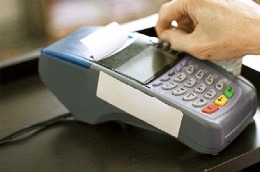 Stable economic growth has boosted consumption among Vietnamese people and gradually seen them approach convenient personal finance services like credit cards. Young people, in particular, represent a future pool of cardholders for bank and financial services companies.
Stable economic growth has boosted consumption among Vietnamese people and gradually seen them approach convenient personal finance services like credit cards. Young people, in particular, represent a future pool of cardholders for bank and financial services companies.Figures from market researchers the Nielsen Company show there are 600,000 credit cards in Vietnam, or two per cent of its 86 million population. Nielsen analysts believe the number is low compared with the size of the market. Vietnam has a young population, with 56 per cent being under the age of 30, according to a recent report from US Central Bureau, International Database. With its young population, high economic growth and a rapid process of economic integration, many analysts say that Vietnamese people are willing to approach new technologies and ideas and apply them quickly in life and work. Bankers believe Vietnamese consumers will eventually shed their long-term habit of paying in cash and the number of consumers paying by credit card will increase greatly in the immediate future.
According the Nielsen survey, awareness among consumers of both debit and credit cards has increased significantly over the past five years. Although the number of cardholders accounts for just two per cent of the population, it’s estimated to grow to 7 per cent in the future. “It’s an amazing figure,” one banker said.
According to the banker, there are two distinct groups: from 25 to 30 years of age and from 30 to 40 years of age. Few of the first group have been successful in their careers just yet but many in the second group have been. This second group is indeed the key cardholders for banks, he added. But while the first group doesn’t have the existing potential, that will change as time passes.
Ms Hang Nga, a 34-year-old consultant in export-import in Hanoi, is a key cardholder. She often travels abroad on business, so using a credit card gives her convenience. “I can also go shopping here without cash or having to wait for my salary,” she said. “Having a credit card makes me feel safer than carrying cash.”
Ms Nguyen Thuy Trang, meanwhile, works for a foreign company and is a stylish 26-year-old. She often shops online and pays by credit card. “The internet is good for both information and for shopping,” she said. “Wherever you are, you can buy what you want from shopping websites. E-commerce is now more common in Vietnam.” But Trang said that her friends don’t use credit cards because they are afraid of the registration procedures and can’t provide evidence of financial capacity. These are barriers to the banks, in the view of Nielsen analysts. According to its survey, key barriers to banking are lengthy application procedures (63 per cent of respondents), collateral (49 per cent), financial evidence (48 per cent) and high interest rates (38 per cent).
According to Ms Nguyen Thi Thanh Hang, Director of Vietcombank Card Centre and Vice Chairman of the Vietnam Card Association, merchants focus on high-level customers or foreigners working in Vietnam, and are unwilling to cater to other groups of customers, including younger people. They want these customers pay cash. Many merchants charge fees to customers when they pay by credit card because they don’t want to pay the fee to the bank, which goes against international practice.
Many banks have not paid adequate attention to promoting their banking services to consumers, especially to young people, Mr Tran Quang Thoai from the Vietnam International Bank (VIB) was quoted as saying. Or they have not educated people on the benefits of credit cards and online transactions.
Vietcombank has free registration programs for those who want a credit card and also hold programs to encourage cardholders who spend often. They combine with large trade centres conduct gift programs for customers. Ms Hang said that these activities are aimed at stimulating consumption, and through programs they also educate merchants on better serving customers with credit cards. Therefore, the number of merchants will be expanded, including stores, shopping malls, airline agencies, etc.
One of the solutions to addressing the identified barriers, according to Ms Hang, is for banks to encourage employers to pay salaries into bank accounts, which would help them to verify information about cardholders and applicants. The State Bank of Vietnam has identified 2010 as a key year in promoting non-cash payments. By the end of the year it is anticipated that at least 55 per cent of employers will pay their staff by bank transfer. The central bank is therefore ensuring that banking infrastructure (ATMs and POS) can handle the increased transactions.
Banking analysts view the second group as being “gold” customers, so banks should provide them with incentives like discounts and promotional programs to stimulate card use. The first group, meanwhile, are the gold customers of tomorrow, and should be the focus of greater efforts.
Không có nhận xét nào:
Đăng nhận xét